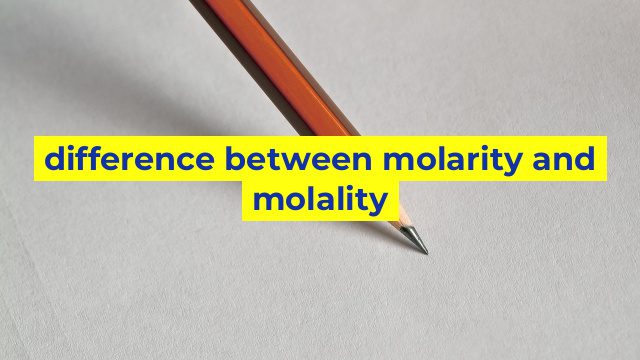The Fundamental Differences Between Molarity and Molality
When it comes to chemistry, two of the most frequently used terms are molarity and molality. While both deal with the concentration of solutions, these two concepts are not interchangeable. In this article, we will discuss the fundamental differences between molarity and molality.
What Is Molarity?
Molarity (M) is a term used to denote the concentration of a solution in terms of the number of moles of solute per liter of solution. This means that molarity is defined as the number of moles of solute per unit volume of the solution. The unit of molarity is moles per liter (mol/L).
Molarity is commonly used in laboratory settings where solutions are prepared and measured volumetrically. This is because molarity is directly related to volume as it is based on the number of moles of solute per unit volume of the solution.
What Is Molality?
Molality (m) is another term used to describe the concentration of a solution. However, unlike molarity, molality is defined as the number of moles of solute per kilogram of solvent. The unit of molality is moles per kilogram (mol/kg).
Molality is generally used when temperature changes are involved in the reaction. This is because the concentration of a solution is independent of temperature when it is expressed in terms of molality.
The Key Differences Between Molarity and Molality
The primary difference between molarity and molality is the units they use to express concentration. Molarity is based on the volume of the solution, while molality is based on the mass of the solvent. Molarity is dependent on temperature, and its concentration changes with temperature, while molality is independent of temperature.
Another critical difference is that molarity is generally used for reactions that do not involve a change in volume, while molality is used for reactions that involve a change in volume. Therefore, when measuring concentration, it is crucial to select the appropriate unit to ensure accurate results.
In closing, while molarity and molality are related concepts that refer to the concentration of a solution, their fundamental differences make them suitable for different situations. Understanding these differences and selecting the appropriate concentration unit can significantly affect the outcomes of chemical reactions.
Table difference between molarity and molality
| Parameter | Molarity | Molality |
|---|---|---|
| Definition | Number of moles of solute per liter of solution | Number of moles of solute per kilogram of solvent |
| Units | mol/L or M | mol/kg |
| Dependence on temperature | Significant | Minimal |
| Used in | Chemical reactions, for comparison with other solutions | Cryoscopy and ebullioscopy experiments where temperature changes are too small to significantly impact the molality |
| Formula | Molarity = moles of solute / liters of solution | Molality = moles of solute / kilograms of solvent |

